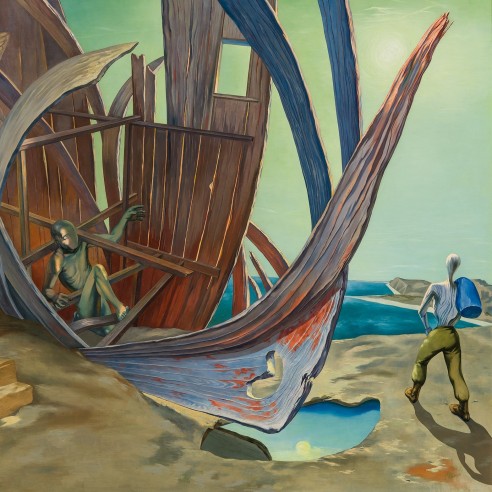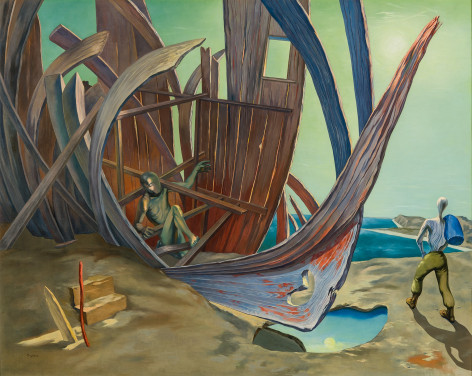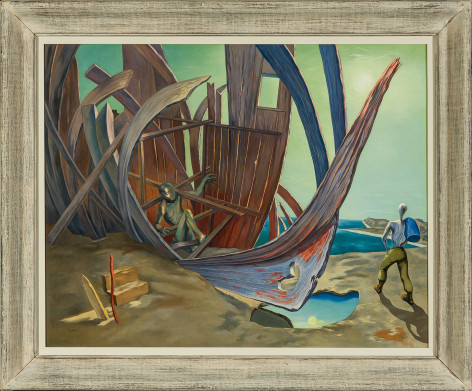
OSVALDO LOUIS GUGLIELMI (1906–1956)
An Odyssey for Moderns, by 1943
Oil on canvas, 24 x 30 in.
Signed (at lower left): Guglielmi
RECORDED: Harry Salpeter, “The Britannica Collection of Art,” Esquire Magazine (August 1943), p. 69 illus. in color // Grace Pagano, “The War—As Seven Artists in the Britannica Collection See It,” The Art Digest 19 (April 1, 1945), pp. 36 illus., 38, 46 // John Baker, O. Louis Guglielmi: A Retrospective Exhibition, exhib. cat. (New Brunswick, New Jersey: Rutgers University Art Gallery, 1980–81), p. 34 fig. 63 illus. as “unlocated”
EXHIBITED: Multiple venues, 1945–50, Encyclopædia Britannica Collection of Contemporary American Painting, no. 49 illus.
EX COLL.: the artist; to [Downtown Gallery, New York. 1943]; to Encyclopædia Britannica, Chicago, 1943; to William Benton, New York and Southport, Connecticut, 1948; by gift to Leonard Schine, Westport, Connecticut, c. 1952; to his widow, Lois Gildersleeve Schine, 1982; to her estate, 2022 until the present
An Odyssey for Moderns was painted at a high point in Guglielmi’s career as a Magic Realist. The term magic realism was coined in 1925 by a German art critic, Franz Roh, to describe art and literature set against a backdrop of mundane subjects where the real world was portrayed, but altered and marvelous in ways that defy expectations and rationality. In 1942, Alfred Barr defined the phrase as “a term sometimes applied to the work of painters who by means of an exact realistic technique try to make plausible and convincing their improbable, dreamlike or fantastic visions.” The style gained significant popularity as a literary device used by writers including the Russian Mikhail Bulgakov (1891–1940), and the Argentinian Jorge Luis Borges (1899–1986), both cultural contemporaries of Guglielmi. Guglielmi has most aptly, perhaps, been called a social surrealist.
The painting was acquired by the Encyclopedia Britannica for its touring collection of American paintings from 1945–50. The Britannica Collection was administered by distinguished Advisory Board comprised of artists, curators, and museum leaders across the nation, tasked with a deliberate agenda to include a diversity of styles, schools, and subject matter. The unifying principal was that all the artists identified as American, either native born or naturalized. The Britannica published two substantial catalogues of its collection in 1945 and 1946. In his contribution to these catalogue, Guglielmi offered this explanation of An Odyssey for Moderns:
The picture Odyssey for Moderns was begun in the early dark months of our travail of the present struggle. A lost people, crawling dreamlike through the rotted timbers of a beached hulk, to win the beach for tomorrow. The soldier at the right, a segment of the bleached wood, of the old world, contemplates the hurricane sun and the distant horizon. That is the suggestive meaning of the picture in a broad sense, and is the result of a persistent dream, caused by anxiety.


